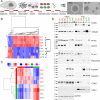Extracellular Vesicles from High-Grade Glioma Exchange Diverse Pro-oncogenic Signals That Maintain Intratumoral Heterogeneity
- PMID: 27013191
- PMCID: PMC4873326
- DOI: 10.1158/0008-5472.CAN-15-3432
Extracellular Vesicles from High-Grade Glioma Exchange Diverse Pro-oncogenic Signals That Maintain Intratumoral Heterogeneity
Abstract
A lack of experimental models of tumor heterogeneity limits our knowledge of the complex subpopulation dynamics within the tumor ecosystem. In high-grade gliomas (HGG), distinct hierarchical cell populations arise from different glioma stem-like cell (GSC) subpopulations. Extracellular vesicles (EV) shed by cells may serve as conduits of genetic and signaling communications; however, little is known about how HGG heterogeneity may impact EV content and activity. In this study, we performed a proteomic analysis of EVs isolated from patient-derived GSC of either proneural or mesenchymal subtypes. EV signatures were heterogeneous, but reflected the molecular make-up of the GSC and consistently clustered into the two subtypes. EV-borne protein cargos transferred between proneural and mesenchymal GSC increased protumorigenic behaviors in vitro and in vivo Clinically, analyses of HGG patient data from the The Cancer Genome Atlas database revealed that proneural tumors with mesenchymal EV signatures or mesenchymal tumors with proneural EV signatures were both associated with worse outcomes, suggesting influences by the proportion of tumor cells of varying subtypes in tumors. Collectively, our findings illuminate the heterogeneity among tumor EVs and the complexity of HGG heterogeneity, which these EVs help to maintain. Cancer Res; 76(10); 2876-81. ©2016 AACR.
©2016 American Association for Cancer Research.
Figures




References
-
- Phillips HS, Kharbanda S, Chen R, Forrest WF, Soriano RH, Wu TD, et al. Molecular subclasses of high-grade glioma predict prognosis, delineate a pattern of disease progression, and resemble stages in neurogenesis. Cancer Cell. 2008;9:157–73. - PubMed
MeSH terms
Grants and funding
LinkOut - more resources
Full Text Sources
Other Literature Sources
Medical
Research Materials

